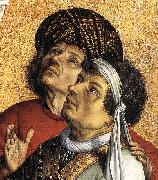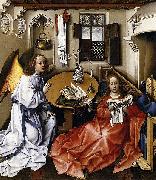Master Of Flemalle Huiler la Reproduction de TableauAll Master Of Flemalle Oil PaintingsRobert Campin (c. 1375 - 26 April 1444), now usually identified as the artist known as the Master of Flemalle, is usually considered the first great master of Flemish and Early Netherlandish painting. This had been a matter of controversy for decades; Campin's life is relatively well documented for the period, but no works in assessable condition could be securely connected with him, whilst a corpus of work had been attached to the unidentified "Master of Flemalle", named after the supposed origin of a work. Campin seems to have had relatives in Valenciennes. He first appears as settled in Tournai from the archives of 1405-6, as a free master of the guild of painters, and he bought citizenship in 1410, which suggests he was not born there. He eventually attained the office of dean of the guild, and wardenship of a church and other civic offices, and was running a large workshop. By 1432, however, he lost his civic positions because of scandals, and probably his role in political disturbances in the city. In 1429 he was found guilty of withholding evidence, and sentenced to go on a pilgrimage, and in 1432 was convicted of adultery and banished for a year. Margaret of Burgundy, wife of the Count of Holland and sister of John the Fearless, Duke of Burgundy intervened on his behalf, and this was reduced to a fine. The dated Werl Altarpiece (1438) shows he continued to work (the two outer wings are in the Prado; the main panel is lost). |
|||

|
|||
|
|
|||
|
||||||||||||
| Master Of Flemalle Robert Campin (c. 1375 - 26 April 1444), now usually identified as the artist known as the Master of Flemalle, is usually considered the first great master of Flemish and Early Netherlandish painting. This had been a matter of controversy for decades; Campin's life is relatively well documented for the period, but no works in assessable condition could be securely connected with him, whilst a corpus of work had been attached to the unidentified "Master of Flemalle", named after the supposed origin of a work. Campin seems to have had relatives in Valenciennes. He first appears as settled in Tournai from the archives of 1405-6, as a free master of the guild of painters, and he bought citizenship in 1410, which suggests he was not born there. He eventually attained the office of dean of the guild, and wardenship of a church and other civic offices, and was running a large workshop. By 1432, however, he lost his civic positions because of scandals, and probably his role in political disturbances in the city. In 1429 he was found guilty of withholding evidence, and sentenced to go on a pilgrimage, and in 1432 was convicted of adultery and banished for a year. Margaret of Burgundy, wife of the Count of Holland and sister of John the Fearless, Duke of Burgundy intervened on his behalf, and this was reduced to a fine. The dated Werl Altarpiece (1438) shows he continued to work (the two outer wings are in the Prado; the main panel is lost). |
||||||||||||
|
|
||||||||||||
| ID de tableau:: 89131 The Crucified Thief The Crucified Thief 1410(1410) Medium oil on wood cyf 1410(1410) Medium oil on wood cyf |
||||||||||||
|
|
||||||||||||
| ID de tableau:: 91191 Merode Altarpiece Merode Altarpiece 1427(1427) Medium oil on panel cyf 1427(1427) Medium oil on panel cyf |
||||||||||||
|
|
||||||||||||
| ID de tableau:: 96948 Virgin and Child Virgin and Child circa 1410(1410) Medium oil on panel cyf circa 1410(1410) Medium oil on panel cyf |
||||||||||||
|
|
||||||||||||
|
| Artiste précédent Artiste prochain | |||||||||||
|
|
||||||||||||
|
Master Of Flemalle Robert Campin (c. 1375 - 26 April 1444), now usually identified as the artist known as the Master of Flemalle, is usually considered the first great master of Flemish and Early Netherlandish painting. This had been a matter of controversy for decades; Campin's life is relatively well documented for the period, but no works in assessable condition could be securely connected with him, whilst a corpus of work had been attached to the unidentified "Master of Flemalle", named after the supposed origin of a work. Campin seems to have had relatives in Valenciennes. He first appears as settled in Tournai from the archives of 1405-6, as a free master of the guild of painters, and he bought citizenship in 1410, which suggests he was not born there. He eventually attained the office of dean of the guild, and wardenship of a church and other civic offices, and was running a large workshop. By 1432, however, he lost his civic positions because of scandals, and probably his role in political disturbances in the city. In 1429 he was found guilty of withholding evidence, and sentenced to go on a pilgrimage, and in 1432 was convicted of adultery and banished for a year. Margaret of Burgundy, wife of the Count of Holland and sister of John the Fearless, Duke of Burgundy intervened on his behalf, and this was reduced to a fine. The dated Werl Altarpiece (1438) shows he continued to work (the two outer wings are in the Prado; the main panel is lost). |
||||||||||||
|
|
||||||||||||
|
CONTACTER DES Etats-Unis |








